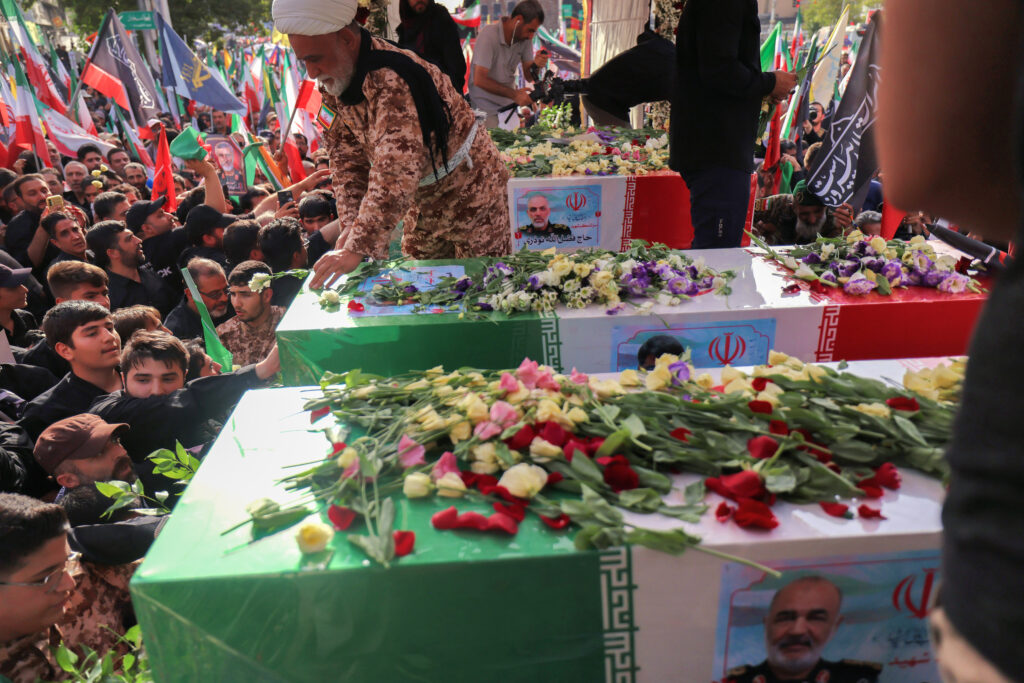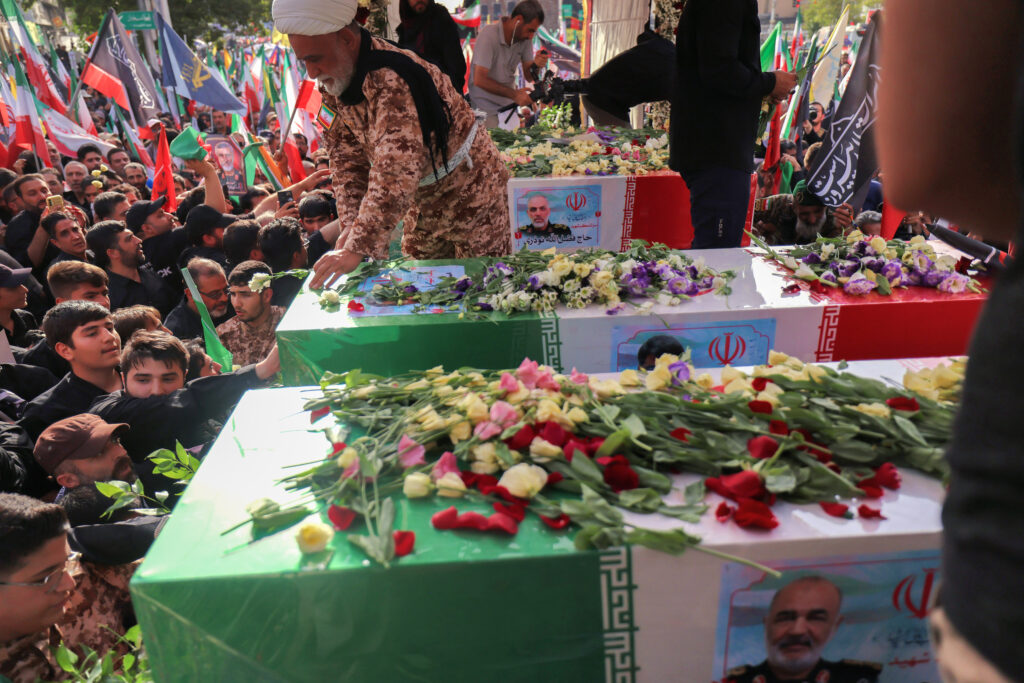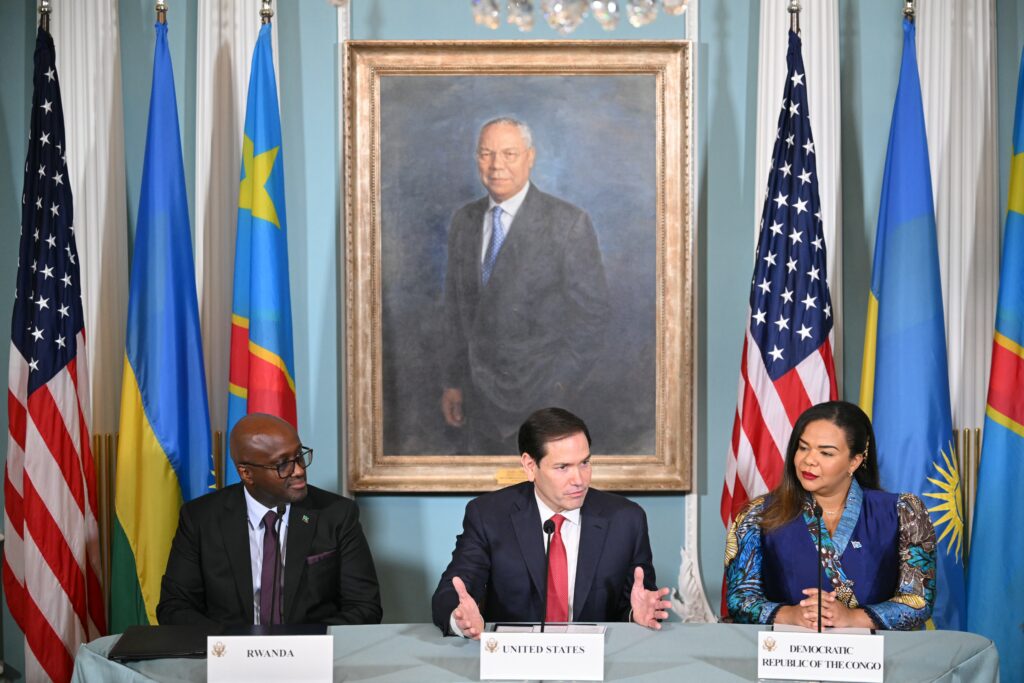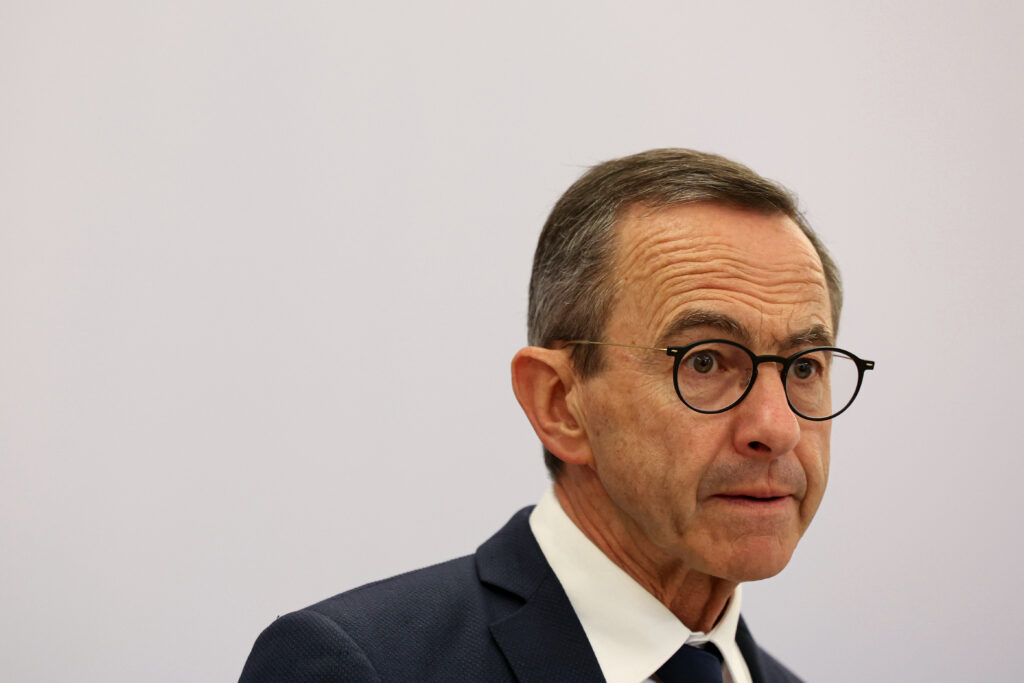Funérailles nationales en Iran pour les hauts gradés tués par Israël
Une foule immense a assisté samedi à Téhéran aux funérailles nationales d’une soixantaine de hauts gradés et scientifiques du nucléaire tués pendant la récente guerre avec Israël, au cinquième jour d’un cessez-le-feu toujours incertain après de nouvelles menaces de Donald Trump.Des milliers d’Iraniens, criant “Mort à l’Amérique” et “Mort à Israël”, se sont rassemblés dès le lever du jour dans le centre de Téhéran, autour des cercueils recouverts de drapeaux iraniens et portant des portraits des commandants tués en uniforme. Le cortège parti de la place Enghelab (Révolution) s’est rendu place Azadi (Liberté), distante de 11 kilomètres, sur fond de musique pop iranienne accompagnant l’éloge funèbre. Après avoir participé aux cérémonies, le président Massoud Pezeshkian a remercié les Iraniens pour s’être associés à cet hommage. “Je vous remercie, chers compatriotes, du fond du coeur, vous avez accompagné les martyrs de la patrie avec amour et la voix de notre unité a atteint les oreilles du monde”, a-t-il déclaré sur X. “Servir une nation aussi libre est l’honneur de ma vie. Pour toujours, Iran!”, a-t-il ajouté.La présence du guide suprême, l’ayatollah Ali Khamenei, n’a pas été confirmée. Au pouvoir depuis 1989, il a dans le passé présidé les funérailles nationales, notamment l’an dernier après la mort dans un accident d’hélicoptère du président d’alors, Ebrahim Raïssi.Un de ses conseillers, Ali Shamkhani, blessé durant la guerre, a lui été aperçu avec une canne.La télévision d’Etat a également montré le général Esmaïl Qaani, responsable de la Force Qods, la branche des opérations extérieures des Gardiens de la Révolution, l’armée idéologique de la République islamique.Dans la rue, des milliers d’Iraniens ont brandi des drapeaux de la République islamique, le poing levé.”Boom boom Tel-Aviv”, proclamait une banderole, en référence aux missiles iraniens tirés sur Israël durant le conflit en représailles à des attaques contre l’Iran. Des répliques de missiles étaient exposées dans le cortège. Des drapeaux israéliens et américains ont été piétinés par la foule.- “Historique” -Israël a déclenché le 13 juin une guerre dans le but affiché d’empêcher l’Iran de se doter de la bombe atomique. La République islamique dément avoir une telle ambition mais revendique un droit au nucléaire civil. “Les Iraniens ont donné de leur sang, pas leur terre; ils ont donné leurs proches, pas leur honneur; ils ont résisté à une pluie de bombes de mille tonnes, mais ils ne se sont pas rendus”, a écrit le chef de la diplomatie iranienne, Abbas Araghchi, sur Instagram.Samedi “sera un jour historique pour l’Iran islamique et l’histoire de la révolution”, avait assuré vendredi Mohsen Mahmoudi, un responsable religieux pour la province de Téhéran.Les administrations et de nombreux commerces sont restés fermés.L’Iran a ainsi rendu hommage à une soixantaine de militaires de haut rang et des Gardiens de la Révolution, ainsi que des scientifiques liés au programme nucléaire tués par les bombardements israéliens. Mohammad Bagheri, puissant général des forces armées iraniennes, tué au premier jour de la guerre, devait être enterré avec sa femme et sa fille.M. Bagheri était le plus haut gradé des forces iraniennes, responsable à la fois de l’armée, du Corps des Gardiens de la Révolution et du programme balistique du pays. Il travaillait directement sous l’autorité du guide suprême, ultime décisionnaire et commandant en chef des forces armées.- “Une raclée” -Selon le ministère iranien de la Santé, au moins 627 personnes ont été tuées et près de 4.900 blessées parmi la population civile durant les 12 jours de guerre.Les tirs iraniens de représailles vers Israël ont fait 28 morts, selon les autorités israéliennes.Les Etats-Unis ont bombardé trois sites nucléaires en Iran dans la nuit du 21 au 22 juin, se joignant à l’offensive d’Israël.Vendredi, le président américain a affirmé que les Etats-Unis mèneraient “sans aucun doute” de nouvelles frappes en Iran si le pays enrichissait l’uranium à des niveaux lui permettant de fabriquer des armes nucléaires. Il a aussi accusé l’ayatollah Khamenei de manquer de reconnaissance, affirmant lui avoir évité “une mort affreuse et ignominieuse”.”Je savais exactement où il s’abritait”, a déclaré Donald Trump, se vantant d’avoir infligé “une raclée” à l’Iran.Téhéran a démenti reprendre des négociations avec les Etats-Unis sur son programme nucléaire, comme l’avait affirmé cette semaine Donald Trump. “Si le président Trump souhaite réellement conclure un accord, il devrait mettre de côté son ton irrespectueux et inacceptable à l’égard du guide suprême iranien”, a écrit Abbas Araghchi sur X.
Funérailles nationales en Iran pour les hauts gradés tués par Israël
Une foule immense a assisté samedi à Téhéran aux funérailles nationales d’une soixantaine de hauts gradés et scientifiques du nucléaire tués pendant la récente guerre avec Israël, au cinquième jour d’un cessez-le-feu toujours incertain après de nouvelles menaces de Donald Trump.Des milliers d’Iraniens, criant “Mort à l’Amérique” et “Mort à Israël”, se sont rassemblés dès le lever du jour dans le centre de Téhéran, autour des cercueils recouverts de drapeaux iraniens et portant des portraits des commandants tués en uniforme. Le cortège parti de la place Enghelab (Révolution) s’est rendu place Azadi (Liberté), distante de 11 kilomètres, sur fond de musique pop iranienne accompagnant l’éloge funèbre. Après avoir participé aux cérémonies, le président Massoud Pezeshkian a remercié les Iraniens pour s’être associés à cet hommage. “Je vous remercie, chers compatriotes, du fond du coeur, vous avez accompagné les martyrs de la patrie avec amour et la voix de notre unité a atteint les oreilles du monde”, a-t-il déclaré sur X. “Servir une nation aussi libre est l’honneur de ma vie. Pour toujours, Iran!”, a-t-il ajouté.La présence du guide suprême, l’ayatollah Ali Khamenei, n’a pas été confirmée. Au pouvoir depuis 1989, il a dans le passé présidé les funérailles nationales, notamment l’an dernier après la mort dans un accident d’hélicoptère du président d’alors, Ebrahim Raïssi.Un de ses conseillers, Ali Shamkhani, blessé durant la guerre, a lui été aperçu avec une canne.La télévision d’Etat a également montré le général Esmaïl Qaani, responsable de la Force Qods, la branche des opérations extérieures des Gardiens de la Révolution, l’armée idéologique de la République islamique.Dans la rue, des milliers d’Iraniens ont brandi des drapeaux de la République islamique, le poing levé.”Boom boom Tel-Aviv”, proclamait une banderole, en référence aux missiles iraniens tirés sur Israël durant le conflit en représailles à des attaques contre l’Iran. Des répliques de missiles étaient exposées dans le cortège. Des drapeaux israéliens et américains ont été piétinés par la foule.- “Historique” -Israël a déclenché le 13 juin une guerre dans le but affiché d’empêcher l’Iran de se doter de la bombe atomique. La République islamique dément avoir une telle ambition mais revendique un droit au nucléaire civil. “Les Iraniens ont donné de leur sang, pas leur terre; ils ont donné leurs proches, pas leur honneur; ils ont résisté à une pluie de bombes de mille tonnes, mais ils ne se sont pas rendus”, a écrit le chef de la diplomatie iranienne, Abbas Araghchi, sur Instagram.Samedi “sera un jour historique pour l’Iran islamique et l’histoire de la révolution”, avait assuré vendredi Mohsen Mahmoudi, un responsable religieux pour la province de Téhéran.Les administrations et de nombreux commerces sont restés fermés.L’Iran a ainsi rendu hommage à une soixantaine de militaires de haut rang et des Gardiens de la Révolution, ainsi que des scientifiques liés au programme nucléaire tués par les bombardements israéliens. Mohammad Bagheri, puissant général des forces armées iraniennes, tué au premier jour de la guerre, devait être enterré avec sa femme et sa fille.M. Bagheri était le plus haut gradé des forces iraniennes, responsable à la fois de l’armée, du Corps des Gardiens de la Révolution et du programme balistique du pays. Il travaillait directement sous l’autorité du guide suprême, ultime décisionnaire et commandant en chef des forces armées.- “Une raclée” -Selon le ministère iranien de la Santé, au moins 627 personnes ont été tuées et près de 4.900 blessées parmi la population civile durant les 12 jours de guerre.Les tirs iraniens de représailles vers Israël ont fait 28 morts, selon les autorités israéliennes.Les Etats-Unis ont bombardé trois sites nucléaires en Iran dans la nuit du 21 au 22 juin, se joignant à l’offensive d’Israël.Vendredi, le président américain a affirmé que les Etats-Unis mèneraient “sans aucun doute” de nouvelles frappes en Iran si le pays enrichissait l’uranium à des niveaux lui permettant de fabriquer des armes nucléaires. Il a aussi accusé l’ayatollah Khamenei de manquer de reconnaissance, affirmant lui avoir évité “une mort affreuse et ignominieuse”.”Je savais exactement où il s’abritait”, a déclaré Donald Trump, se vantant d’avoir infligé “une raclée” à l’Iran.Téhéran a démenti reprendre des négociations avec les Etats-Unis sur son programme nucléaire, comme l’avait affirmé cette semaine Donald Trump. “Si le président Trump souhaite réellement conclure un accord, il devrait mettre de côté son ton irrespectueux et inacceptable à l’égard du guide suprême iranien”, a écrit Abbas Araghchi sur X.
Nîmes: six blessés, dont quatre mineurs, dans une fusillade, sur fond de trafic de drogue
Une fusillade a fait six blessés, dont quatre mineurs, vendredi soir à Nîmes, lorsque des tireurs ont ouvert le feu sur une place entourée d’immeubles, vraisemblablement sur fond de rivalités liées au trafic de drogue.La fusillade a éclaté peu avant 19H00 dans le quartier populaire de Valdegour, dans l’ouest de la ville, limitrophe du quartier de Pissevin, gangréné par le trafic de stupéfiants et déjà théâtre de plusieurs fusillades sanglantes.Elle a fait six blessés “âgés de 15 ans, deux de 16 ans, 17 ans, 18 ans, et 20 ans”, a précisé la procureure de Nîmes Cécile Gansac dans un communiqué samedi après-midi, après que des informations de sources policières eurent évoqué jusqu’à huit personnes touchées.”Les victimes de 15 ans et 17 ans restent hospitalisées dans un état préoccupant. Leur pronostic vital ne serait cependant plus engagé”, a ajouté la procureure.”Trois ont été victimes d’éclats de balles et présentent un état de santé hors de danger” et la plus âgée est sortie de l’hôpital, selon la magistrate.Le communiqué indique qu’à l’arrivée de la police sur les lieux vers 19H00, des témoins de l’attaque “faisaient état de tirs en rafale par des individus arrivés et repartis en véhicule”. “Les investigations techniques et scientifiques se poursuivent actuellement afin d’identifier le ou les auteurs des faits, de déterminer les circonstances exactes du passage à l’acte, ses causes et ses motivations”, poursuit Cécile Gensac.Elle n’avance pas de piste privilégiée, alors que des sources ont rapidement évoqué un possible conflit autour du trafic de stupéfiants, présent dans le quartier de Valdegour, où a eu lieu la fusillade, et dans le quartier voisin de Pissevin.Des sources policières ont de leur côté fait état de témoignages évoquant trois personnes arrivant du quartier de Pissevin et ayant ouvert le feu avant de s’enfuir à bord de deux véhicules. Une vingtaine d’étuis de calibre .222 Remington, plutôt utilisé pour le tir sportif ou la chasse, ont été retrouvés sur place, selon ces sources.Il n’était pas clair si les personnes touchées étaient directement visées ou des victimes collatérales, alors qu’au moment de l’attaque, selon des témoignages, la place commençait à se remplir d’habitants sortant de chez eux après une journée de chaleur caniculaire.- “Il faut faire quelque chose” -Le quartier de la place Avogadro où s’est déroulée la fusillade est “cartographié comme étant un point de deal”, avait précisé tard vendredi Nathalie Welté, procureure adjointe de Nîmes.Et selon une source proche de l’enquête, une rivalité sur fond de stupéfiants pourrait être à l’origine de la fusillade. Le quartier voisin de Pissevin, dont 70% des 16.000 habitants vivent sous le seuil de pauvreté, est en effet connu pour ses points de deal et a été lui aussi théâtre de fusillades liées au trafic.En août 2023, un garçonnet de 10 ans y avait été tué, fauché par une balle perdue, déclenchant une vive émotion. Des ministres de l’Intérieur se sont régulièrement rendus sur place et une importante opération de rénovation y a été lancée l’an dernier.”Ce ne sont pas des gens d’ici, ce sont des gens d’en bas, de la Zup Sud (nom donné à Pissevin, NDLR) qui font ça. Ils ont toujours fait ça, et ils continueront toujours tant que la loi ne fait pas son travail”, réagissait samedi matin un habitant du quartier Valdegour, qui n’a pas souhaité donner son nom mais seulement son âge, 28 ans.”Nous, on en a marre, on a peur, on n’est plus en sécurité ici (…). Il faut faire quelque chose”, a-t-il dit à l’AFP.”Ils ont mis un commissariat, mais il ne sert à rien, on ne voit jamais de policiers, on ne voit jamais de patrouille qui passe, rien, ce n’est pas normal”, a souligné le jeune homme, l’un des rares riverains à s’aventurer dans le quartier écrasé de chaleur et où aucune présence des forces de l’ordre n’était visible.Possibles stigmates de la fusillade, des traces de sang étaient elles toujours visibles samedi, de même qu’un impact de balle sur un poteau.
Rwanda, DR Congo sign peace deal in US after rebel sweepSat, 28 Jun 2025 14:47:10 GMT
Rwanda and the Democratic Republic of Congo have signed a peace agreement Washington to end fighting that has killed thousands, with the two countries pledging to pull back support for guerrillas — and President Donald Trump boasting of securing mineral wealth.”Today, the violence and destruction comes to an end, and the entire region begins a …
Rwanda, DR Congo sign peace deal in US after rebel sweepSat, 28 Jun 2025 14:47:10 GMT Read More »
LR: Retailleau s’entoure d’une direction élargie et renouvelle les instances du parti
Bruno Retailleau s’est entouré de 13 vice-présidents à la tête des Républicains (LR), ainsi que d’un bureau politique et d’une commission d’investiture renouvelés, annoncés samedi lors du conseil national du parti, près d’un mois après sa large victoire face à Laurent Wauquiez.Après sa victoire du 17 mai, le ministre de l’Intérieur avait dans un premier temps annoncé un organigramme de direction resserré essentiellement composés de proches, avec notamment l’eurodéputé François-Xavier Bellamy comme vice-président délégué, Othman Nasrou comme secrétaire général et la ministre Annie Genevard à la tête de la commission d’investiture.La liste des 13 vice-présidents dévoilée samedi, lors du conseil national réuni à la Mutualité à Paris, comprend des soutiens de Laurent Wauquiez lors de l’élection interne, dont les élus franciliens Geoffroy Didier et Florence Portelli et le ministre Yannick Neuder.Le maire de Cannes et président de l’Association des maires de France (AMF) David Lisnard, qui a créé son propre parti, Nouvelle Energie, associé à LR, est également nommé vice-président, de même que l’eurodéputée Céline Imart, les députés Antoine Vermorel-Marques et François-Xavier Ceccoli, les sénatrices Laurence Garnier et Jacqueline Eustache-Brinio, l’ancien trésorier Daniel Fasquelle, l’élue marseillaise Catherine Pila et les anciens députés Julien Aubert et Guillaume Larrivé.Le nouveau patron de LR a par ailleurs renouvelé samedi le bureau politique et la commission nationale d’investiture. Laurent Wauquiez avait demandé une représentation à hauteur de son résultat (25,7%) lors de l’élection interne.Equilibres respectés ? “On avance”, a simplement répondu M. Wauquiez.M. Retailleau s’est également entouré de quatre conseillers spéciaux: la députée Michèle Tabarot, l’ancien eurodéputé Arnaud Danjean, l’ancien président du syndicat patronal CGPME François Asselin et le président du gouvernement de la Nouvelle-Calédonie, Alcide Ponga.Sur le fond, un groupe projet comprend par ailleurs M. Bellamy, Jean-François Copé, le député Philippe Juvin et les sénateurs Christine Lavarde et Jean-François Husson.Les Républicains, qui ont intégré le gouvernement aux côtés des macronistes après la dissolution, réunissent samedi leur conseil national, désormais présidé par Michel Barnier, en présence du président du Parti populaire européen, l’Allemand Manfred Weber.Les LR, qui comptent plus de 120.000 adhérents, tiendront un congrès à l’occasion de leurs universités d’été, les 6 et 7 septembre à Port-Marly (Yvelines).”Il n’y aura pas d’accord national” mais du “cas par cas” avec le bloc central aux municipales, avec deux objectifs: “Faire progresser LR” et “faire barrage à la gauche”, a par ailleurs expliqué M. Nasrou.





